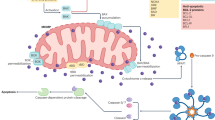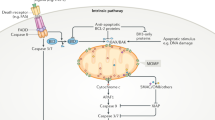Abstract
For many years the P2X7 receptor (P2X7R) was considered the prototypic cytolytic receptor due to its ability to cause dramatic changes in plasma membrane permeability, eventually leading to cell death. However, later studies revealed that controlled P2X7R activation has beneficial effects on cell metabolism and nowadays our perception of the physiological role of this receptor has radically changed. Some of the biochemical pathways underlying the trophic effect of the P2X7R are being unveiled, thus disclosing an unanticipated role of P2X7Rs in mitochondrial and glycolytic metabolism. We provide here an update of the effects of the P2X7R on cell energy metabolism.
Access this chapter
Tax calculation will be finalised at checkout
Purchases are for personal use only
Similar content being viewed by others
References
Steinberg GR, Carling D (2019) AMP-activated protein kinase: the current landscape for drug development. Nat Rev Drug Discov 18(7):527–551
Giuliani AL et al (2019) Extracellular nucleotides and nucleosides as signalling molecules. Immunol Lett 205:16–24
Vultaggio-Poma V et al (2020) Extracellular ATP: a feasible target for cancer therapy. Cells 9(11):2496
Michaud M et al (2011) Autophagy-dependent anticancer immune responses induced by chemotherapeutic agents in mice. Science 334(6062):1573–1577
Pietrocola F et al (2016) Caloric restriction mimetics enhance anticancer immunosurveillance. Cancer Cell 30(1):147–160
Forrester T (1966) Release of adenosine triphosphate from active skeletal muscle. J Physiol 186(2):107P–109P
Wilhelm K et al (2010) Graft-versus-host disease is enhanced by extracellular ATP activating P2X7R. Nat Med 16(12):1434–1438
Burnstock G (2006) Pathophysiology and therapeutic potential of purinergic signaling. Pharmacol Rev 58(1):58–86
Rozengurt E, Heppel LA (1975) A specific effect of external ATP on the permeability of transformed 3T3 cells. Biochem Biophys Res Commun 67(4):1581–1588
Rozengurt E et al (1977) Effect of exogenous ATP on the permeability properties of transformed cultures of mouse cell lines. J Biol Chem 252(13):4584–4590
Murgia M et al (1992) Characterization of the cytotoxic effect of extracellular ATP in J774 mouse macrophages. Biochem J 288(Pt 3):897–901
Zanovello P et al (1990) Responses of mouse lymphocytes to extracellular ATP. II. Extracellular ATP causes cell type-dependent lysis and DNA fragmentation. J Immunol 145(5):1545–1550
Pizzo P et al (1992) Role of P2z purinergic receptors in ATP-mediated killing of tumor necrosis factor (TNF)-sensitive and TNF-resistant L929 fibroblasts. J Immunol 149(10):3372–3378
Dubyak GR (2012) P2X7 receptor regulation of non-classical secretion from immune effector cells. Cell Microbiol 14(11):1697–1706
Mackenzie AB et al (2005) Pseudoapoptosis induced by brief activation of ATP-gated P2X7 receptors. J Biol Chem 280(40):33968–33976
Chiozzi P et al (2019) Amyloid beta-dependent mitochondrial toxicity in mouse microglia requires P2X7 receptor expression and is prevented by nimodipine. Sci Rep 9(1):6475
Adinolfi E et al (2005) Basal activation of the P2X7 ATP receptor elevates mitochondrial calcium and potential, increases cellular ATP levels, and promotes serum-independent growth. Mol Biol Cell 16(7):3260–3272
Sarti AC et al (2021) Mitochondrial P2X7 receptor localization modulates energy metabolism enhancing physical performance. Function 2:zqab005
Griffiths EJ, Rutter GA (2009) Mitochondrial calcium as a key regulator of mitochondrial ATP production in mammalian cells. Biochim Biophys Acta 1787(11):1324–1333
Sluyter R (2017) The P2X7 receptor. Adv Exp Med Biol 1051:17–53
Atkinson L et al (2002) An ATP-gated ion channel at the cell nucleus. Nature 420(6911):42
Kuehnel MP et al (2009) Lipids regulate P2X7-receptor-dependent actin assembly by phagosomes via ADP translocation and ATP synthesis in the phagosome lumen. J Cell Sci 122(Pt 4):499–504
Wieckowski MR et al (2009) Isolation of mitochondria-associated membranes and mitochondria from animal tissues and cells. Nat Protoc 4(11):1582–1590
Di Virgilio F et al (2018) Extracellular ATP and P2 purinergic signalling in the tumour microenvironment. Nat Rev Cancer 18(10):601–618
Gonnord P et al (2009) Palmitoylation of the P2X7 receptor, an ATP-gated channel, controls its expression and association with lipid rafts. FASEB J 23(3):795–805
Ledderose C et al (2016) Mitochondrial dysfunction, depleted purinergic signaling, and defective T cell vigilance and immune defense. J Infect Dis 213(3):456–464
Ledderose C et al (2018) Purinergic P2X4 receptors and mitochondrial ATP production regulate T cell migration. J Clin Invest 128(8):3583–3594
Borges da Silva H et al (2018) The purinergic receptor P2RX7 directs metabolic fitness of long-lived memory CD8(+) T cells. Nature 559(7713):264–268
Ledderose C et al (2020) The purinergic receptor P2Y11 choreographs the polarization, mitochondrial metabolism, and migration of T lymphocytes. Sci Signal 13(651):eaba3300
Giacovazzo G et al (2018) Loss of P2X7 receptor function dampens whole body energy expenditure and fatty acid oxidation. Purinergic Signal 14(3):299–305
Giacovazzo G et al (2019) Stimulation of P2X7 enhances whole body energy metabolism in mice. Front Cell Neurosci 13:390
Glas R et al (2009) Purinergic P2X7 receptors regulate secretion of interleukin-1 receptor antagonist and beta cell function and survival. Diabetologia 52(8):1579–1588
Beaucage KL et al (2014) Loss of P2X7 nucleotide receptor function leads to abnormal fat distribution in mice. Purinergic Signal 10(2):291–304
Meyers DE et al (2013) Mitochondrial cardiomyopathy: pathophysiology, diagnosis, and management. Tex Heart Inst J 40(4):385–394
Joza N et al (2005) Muscle-specific loss of apoptosis-inducing factor leads to mitochondrial dysfunction, skeletal muscle atrophy, and dilated cardiomyopathy. Mol Cell Biol 25(23):10261–10272
Ghezzi D et al (2010) Severe X-linked mitochondrial encephalomyopathy associated with a mutation in apoptosis-inducing factor. Am J Hum Genet 86(4):639–649
Katsyuba E et al (2018) De novo NAD(+) synthesis enhances mitochondrial function and improves health. Nature 563(7731):354–359
Crisol BM et al (2018) Nicotinamide riboside induces a thermogenic response in lean mice. Life Sci 211:1–7
Biswas A et al (2019) Loss of function mutation in the P2X7, a ligand-gated ion channel gene associated with hypertrophic cardiomyopathy. Purinergic Signal 15(2):205–210
Pasqualetti G et al (2017) P2X7 receptor and APOE polymorphisms and survival from heart failure: a prospective study in frail patients in a geriatric unit. Aging Dis 8(4):434–441
Kroemer G, Verkhratsky A (2021) Mitochondrial localization and function of the purinergic receptor P2X7. Function 2:zqab006
Tian T et al (2020) The P2X7 ion channel is dispensable for energy and metabolic homeostasis of white and brown adipose tissues. Purinergic Signal 16(4):529–542
Amoroso F et al (2012) The P2X7 receptor is a key modulator of aerobic glycolysis. Cell Death Dis 3:e370
Acknowledgments
This work was supported by the Italian Association for Cancer Research (AIRC) grants No. IG 13025, IG 18581, IG 22883; the Ministry of University and Research of Italy, PRIN 2017 grant No. 8YTNWC, and funds from the University of Ferrara.
Author information
Authors and Affiliations
Corresponding author
Editor information
Editors and Affiliations
Rights and permissions
Copyright information
© 2022 The Author(s), under exclusive license to Springer Science+Business Media, LLC, part of Springer Nature
About this protocol
Cite this protocol
Di Virgilio, F., Falzoni, S., Sarti, A.C., Chiozzi, P., Vultaggio-Poma, V., Giuliani, A.L. (2022). Modulation of Cell Energy Metabolism by the P2X7 Receptor. In: Nicke, A. (eds) The P2X7 Receptor. Methods in Molecular Biology, vol 2510. Humana, New York, NY. https://doi.org/10.1007/978-1-0716-2384-8_3
Download citation
DOI: https://doi.org/10.1007/978-1-0716-2384-8_3
Published:
Publisher Name: Humana, New York, NY
Print ISBN: 978-1-0716-2383-1
Online ISBN: 978-1-0716-2384-8
eBook Packages: Springer Protocols




